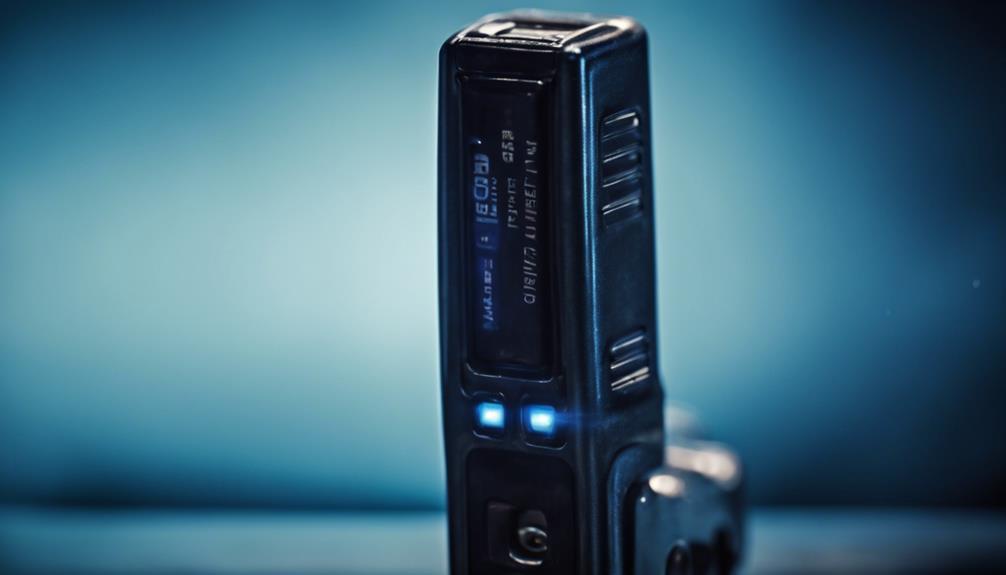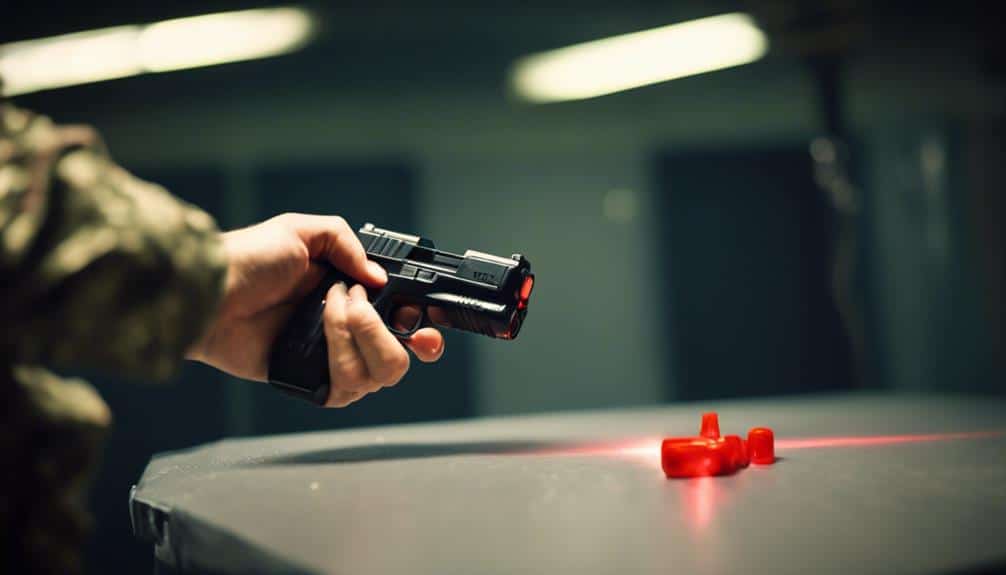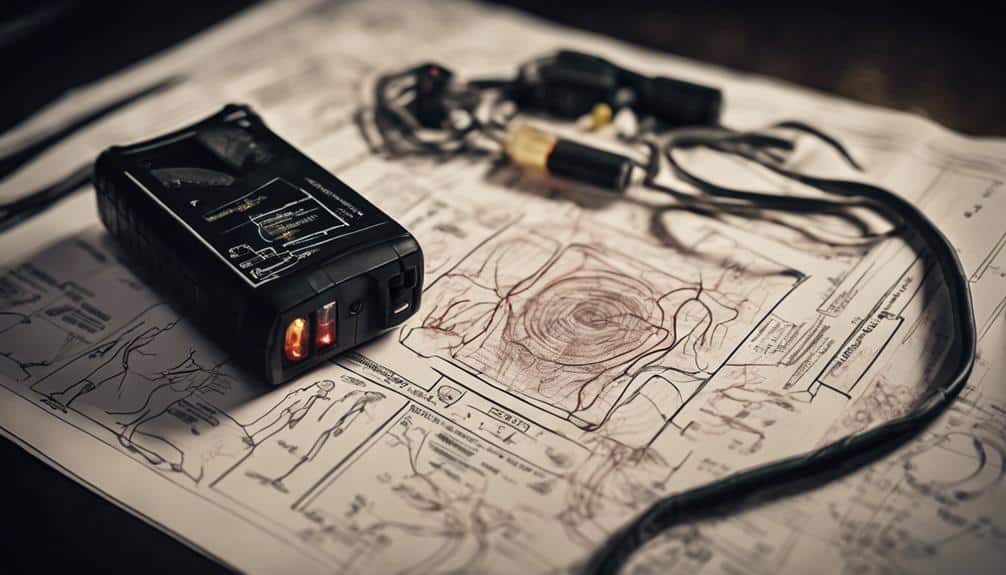Stun guns won’t exactly zap you into oblivion like a sci-fi movie suggests, but let’s clear up some myths. They deliver
high-voltage electrical shocks, causing pain and temporary muscle contractions, yet they’re not meant to be deadly. However, for folks with
underlying health issues, like heart conditions, the risk isn’t zero. Voltage might sound impressive, but amperage determines effectiveness—think of it like comparing a flashy sports car to a reliable family sedan. Misuse, especially targeting sensitive body areas, can spark trouble, including
cardiac issues. With proper understanding and care, you’ll uncover the subtleties separating myth from reality.
Understanding Stun Gun Mechanisms
An understanding of
stun gun mechanisms is essential if you’re considering one for
personal defense. Stun guns, including TASERs and Stun Guns, work by delivering
high-voltage, low-current electrical shocks. Think of them as a shocking wake-up call for an attacker, causing
temporary muscle contractions and pain without knocking anyone out cold like a Hollywood stunt. The real magic happens when you
maintain contact—longer contact equals more disorientation and compliance. While considering a stun gun, it’s important to also
familiarize with local laws to guarantee compliance and avoid legal issues. Now, don’t go thinking you’re a superhero against a mob, as these gadgets aren’t designed for multiple attackers. They need direct contact to work their zapping charm, and clothing can play villain by reducing their effectiveness. TASERs, however, have a clever trick up their sleeve with
barbed projectiles that can penetrate clothing, unlike regular stun guns that require a more intimate approach.
Voltage vs. Amperage
You might think that a
stun gun with sky-high voltage will pack a punch, but in reality, it’s the amperage that does the heavy lifting when it comes to
effectiveness. While
rechargeable models are often praised for their convenience and sustainability, it’s important not to overlook the
amperage specifications that guarantee the device’s functionality. Manufacturers love to dazzle you with voltage numbers, yet it’s the amperage—the electric current—that’s the real MVP in
incapacitating a target, like how your toaster isn’t judged just by how shiny it looks but by how well it can toast your bread. So, when shopping for a reliable stun gun, remember that brands like Omega and ZAP focus on the right amperage specifications, guaranteeing you get a gadget that doesn’t just buzz loudly, but actually delivers the zap you need!
Misleading Voltage Claims
In the domain of stun guns,
misleading voltage claims often muddle the understanding of their
true effectiveness. Manufacturers love to boast about sky-high voltage numbers, but don’t let these flashy figures fool you. Voltage isn’t the superhero here; it’s more of a sidekick. The real power lies in
amperage, the unsung hero that actually determines a stun gun’s ability to
incapacitate. For instance, the
LiL Guy Pink Stun Gun operates at 4.4 milliamps, making it effective in
personal protection despite the
60 million volts it delivers. Yet, due to a lack of
industry regulation, companies often rely on these misleading voltage claims, leaving you scratching your head over what’s truly effective.
Imagine you’re in a store, eyeing two stun guns. One promises a shocking 5 million volts, while the other quietly lists a modest 200,000 volts. You might think the former is your best bet, but if its amperage is low, it’s more bark than bite. Brands like Omega and ZAP understand this, focusing on genuine effectiveness over
marketing gimmicks. So, when choosing a stun gun, remember that understanding the distinction between voltage and amperage is essential. Don’t fall for the
high-voltage hype; instead, equip yourself with knowledge, and you’ll be better prepared for whatever life throws your way.
Importance of Amperage
When it comes to stun guns, the real magic number isn’t the voltage but the amperage. You might think that higher voltage is the key to stopping an attacker, but that’s like trying to judge a book by its cover—it doesn’t tell the whole story. Amperage, the measure of electric current, is what truly impacts how your body responds. Reliable brands like Omega and ZAP understand this, focusing on the right levels of amperage to guarantee their devices are effective yet safe. For instance, the
SAL Pink Stun Gun by Para Bellum Defense offers a high-voltage shock while maintaining a low amperage for safety. Here’s what you should know about amperage:
- It’s the amperage, not voltage, that determines effectiveness. A high-voltage shock may sound intimidating, but it’s the amperage that causes neuromuscular incapacitation.
- Manufacturers’ high voltage claims can be misleading. They often overlook amperage’s role, leading to misconceptions about performance.
- Low amperage is key for safety. Most stun guns deliver a strong jolt but operate at low amperage to avoid lethal harm.
Effective Current Delivery
Although
voltage often grabs the spotlight in stun gun discussions, it’s the
effective delivery of current, or
amperage, that truly defines their
performance. For example, devices like the
100 Million Volt Bouncer Stun Gun boast high voltage, but it’s the amperage that guarantees
effectiveness. You might picture voltage as the flashy star of the show, but it’s the amperage that does the heavy lifting, delivering the essential punch to incapacitate an attacker. Think of it like this: voltage is the doorbell, ringing insistently, while amperage is the one who barges through the door, disrupting electrical signals in muscles.
Stun guns are designed to deliver high-voltage, low-current shocks, and while voltage can vary widely, it doesn’t directly equate to effectiveness. A higher voltage doesn’t guarantee you’ll be sending an assailant to dreamland any faster. It’s all about
reliable current flow, making sure amperage can bypass barriers like
clothing and make direct contact with the
skin. Without this, your stun gun might end up as effective as a flashlight in a blackout—plenty of buzz, but not much impact.
Understanding voltage vs. amperage is vital. While voltage often steals the marketing spotlight, remember: it’s the amperage that decides whether your device truly
packs a punch. So, next time you’re evaluating stun guns, think amperage, not just voltage!
Health Risks and Concerns
When you’re thinking about
stun guns, it’s essential to reflect on the potential for
serious injury, especially if you’re part of a
vulnerable population with pre-existing health issues or a penchant for caffeine-fueled adventures. Imagine the risk of a shock to your heart when you’re already running on adrenaline or Red Bull; it’s like adding fireworks to a bonfire—exciting but potentially disastrous. The amperage of a stun gun, such as the
Hot Shot Stun Gun which can reach 4.8 milliamps, can vary based on battery freshness and greatly impact its effectiveness. And, while stun guns are designed for safety,
misuse and oversight, like holding the trigger too long or aiming at the wrong spot, can turn a non-lethal tool into a real-life game of Operation, minus the buzzer but with all the consequences!
Potential for Serious Injury
Stun guns, while often perceived as
non-lethal self-defense tools, carry
significant risks, particularly if they’re misused. You might think they’re just shock devices, but these gadgets pack more punch than you’d expect, and not always in a good way. The potential for
serious injury isn’t just a myth; it’s a reality, especially if used improperly. Imagine aiming for self-defense and ending up causing
cardiac arrhythmia—it’s like trying to swat a fly and knocking over a vase instead.
Misuse can lead to cardiac problems, especially if the target area is the chest. It’s vital to take into account the voltage of the device; for instance, a stun gun with
100 million volts can be particularly dangerous if not handled correctly. Additionally, lack of
proper training increases risks for both the user and the target. High pain tolerance or aggressive behavior complicates effective use.
Now, you might wonder, how can something with such low current be so risky? Well, it’s all about where and how you use it. Hit the wrong spot, like the chest, and you could be dialing 911 instead of celebrating your safety. Training is imperative, yet often overlooked, leading to prolonged exposure and
heightened injury risk. So, next time you think about a stun gun, remember: it’s not just a zap, it’s a
responsibility.
Impact on Vulnerable Populations
Consider the impact stun guns can have on vulnerable populations. While some might believe these devices are harmless, they can pose significant health risks. Common myths suggest that stun guns are safe for everyone, but individuals with pre-existing conditions or those under the influence of stimulants may experience exacerbated health issues. For example, heightened adrenaline can lessen pain perception, reducing the device’s effectiveness.
| Vulnerable Group |
Potential Impact |
| Elderly |
Higher risk of injury or death |
| Mental Health Disorders |
Dangerous reactions to stun gun use |
| Racial Minorities |
Disproportionate effects and concerns |
The elderly, those with mental health disorders, and racial minorities face disproportionate risks. For instance, the elderly might experience severe injuries or even fatal reactions due to frail health. Additionally, individuals with mental health disorders might suffer dangerous reactions, leading to serious injury or death. Systemic issues also result in racial minorities and individuals with disabilities being disproportionately affected by stun gun use.
Misuse or excessive use can lead to dire consequences, especially when combined with other restraints. It’s essential to debunk these common myths and acknowledge the varying impact on vulnerable populations, ensuring their protection and safety in all situations.
Misuse and Oversight Challenges
Misuse of stun guns isn’t just a theoretical risk—it’s a reality with serious health implications. Imagine you’re in a situation where a stun gun is used without proper judgment—perhaps on someone with a heart condition or under the influence of drugs. The potential for serious injury or even death is strikingly real. You might think it’s just the stuff of police procedurals, but it’s happening more often than you might believe. It’s essential to understand the features of stun guns, such as their
high-voltage shock capability, which can be dangerous if misused.
- Lack of visible marks: Makes accountability tricky, as it’s hard to prove misuse without obvious evidence.
- Public perception: The idea that stun guns are “less-lethal” undermines calls for stringent regulation.
- Historical misuse: Instances show they can become tools for torture without proper oversight.
You see, the absence of visible injuries complicates oversight, making it difficult to hold anyone accountable when misuse occurs. This invisible nature can lead to unchecked abuse, a concern that’s only grown with increased stun gun usage. Advocates argue for better training and oversight, especially for law enforcement, to prevent these “less-lethal” tools from becoming a real threat. So, next time you hear that zap, remember—it’s more than just a buzz; it’s a call for responsibility.
Comparing Stun Guns and TASERs
When comparing
stun guns and
TASERs, it’s crucial to understand their fundamental differences and applications. Imagine you’re a superhero with two gadgets: stun guns and the TASER device. Stun guns are like your trusty sidekick, delivering
high-voltage, low-current shocks that require you to be up close and personal with the villain. They aim for
pain compliance, causing localized discomfort, but their effectiveness can wane against foes with high pain tolerance or those fueled by stimulants. The
80 Million volt Stun Bat, for example, offers a powerful discharge and is designed for
personal safety, though its impact varies by battery charge and the condition of the assailant. On the other hand, the TASER device is your long-distance ally, firing
barbed darts that can incapacitate a suspect from afar. This gadget creates a circuit with electrical current, inducing
neuromuscular incapacitation, which is why
law enforcement agencies often prefer it. It can even penetrate clothing, maintaining its effectiveness regardless of the suspect’s condition—talk about a versatile sidekick!
In addition to its probe mode, the TASER can be used in
drive-stun mode, similar to traditional stun guns, though it’s generally more
effective. While both tools have their merits, understanding these differences helps you choose the right one for the job. Just remember, with great power comes great responsibility—use them wisely!
Legal Implications and Restrictions
When considering a
stun gun for
personal safety, it’s essential to understand that the legal landscape is as varied as a box of chocolates—some states let you have them freely, while others treat them like they’re the crown jewels. For instance, stun gun possession is
illegal in states like Hawaii, New York, Rhode Island, and D.C. You can’t just waltz into any location with a stun gun tucked away, as places like schools and airports have a strict “no stun gun” policy that could land you in hot water faster than you can say “self-defense.” To keep yourself on the right side of the law and avoid any shocking surprises, make sure you know the
local regulations and carry a permit if needed, because misuse can lead to
criminal charges that are definitely not worth the hassle.
Jurisdictional Ownership Variations
Why does the
legal landscape of
stun guns and
TASERs vary so drastically across different jurisdictions? It’s like trying to follow the plot of a soap opera; just when you think you’ve got it figured out, there’s a twist.
Jurisdictional ownership variations exist because each state or local government has its reasons, often influenced by
safety concerns,
crime rates, and public opinion. In the United States, while TASERs are legal in 49 states, the specifics of ownership can feel like traversing a legal labyrinth.
- Some states require permits or licenses, adding an extra layer of paperwork to your self-defense arsenal.
- Others might have outright bans, especially in sensitive public spaces like schools or airports.
- Laws can change faster than your Wi-Fi password, as seen in Rhode Island, making it vital to stay updated.
The
misuse of these devices can land you in hot water, facing criminal charges if you’re not careful. So, it’s important to understand the
local laws and not just assume you’re in the clear. Remember, being informed isn’t just smart—it’s essential for avoiding a shocking legal headache!
Location-Specific Carrying Rules
Steering through the
legal maze of carrying stun guns requires vigilance, especially due to
location-specific rules that can catch you off guard. Imagine this: you’re ready to head out, stun gun in hand, only to discover that your local school or airport has strict
no-carry policies. Oops! In many areas, carrying stun guns in
public places is a big no-no, and getting caught can land you in hot water with
hefty penalties. That’s why it’s essential to know the ins and outs of where you can legally bring these devices.
Across different states, the rules resemble a
patchwork quilt of legalities. Some states roll out the welcome mat for stun gun owners, while others put up a big “Do Not Enter” sign, requiring permits or, worse, enforcing outright bans. It’s like playing a game of legal hopscotch—one wrong move, and you’re out. Additionally, if you’re thinking about owning a
TASER, brace yourself for even stricter rules. They’re like the snobby, high-maintenance cousin of stun guns, demanding more research on
specific state requirements. So, before you set off with your stun gun, do your homework on location-specific carrying rules. You wouldn’t want to zap your way into a legal quagmire!
Legal Consequences of Misuse
Misusing a stun gun can lead to a cascade of legal consequences that you definitely want to avoid. Imagine this: you’ve got a stun gun, maybe as a safety precaution, but using it improperly or in prohibited places can land you in hot water faster than your grandma’s kettle. Legal consequences of misuse can include:
- Criminal Charges: If you use a stun gun irresponsibly, you might face charges ranging from assault to more severe offenses.
- Civil Lawsuits: Injuries caused by misuse can lead to lawsuits, where you could be liable for damages.
- Permit Violations: Owning or carrying a stun gun without the required permits can get you into trouble.
In many areas, stun guns aren’t just something you can toss in your purse like a pack of gum; they require serious consideration of local laws. For instance, bringing one into a school or government building could result in legal repercussions. And let’s not forget, some regions treat Tasers as a whole different ballgame, with stricter regulations. Always verify your local laws before purchasing or carrying a stun gun. Trust me, a little homework now can save you a mountain of headaches later!
Misconceptions About Effectiveness
Over time,
misconceptions about stun guns’ effectiveness have led to misunderstandings about their practical use. You might think that a stun gun, with its
high-voltage zap, will instantly drop anyone like a sack of potatoes. But hold your horses! The reality is, these devices deliver a high-voltage, low-current shock meant for
temporary incapacitation, not guaranteed instant results. Effectiveness hinges on several factors, like
aiming for large muscle groups and making direct skin contact. It’s not just about shocking someone with high voltage; amperage is the real game-changer here.
Imagine trying to subdue a marathon runner or someone hyped up on energy drinks—they might just shrug it off. Studies show that stun guns primarily act as
pain compliance tools, and their impact varies with individuals’
pain tolerance or if they’re under the influence of substances. Unlike their cooler cousin, the TASER, which can incapacitate from a distance like a superhero’s gadget, stun guns demand
close contact. This limitation can be a bit of a buzzkill in certain situations, especially if you’re facing
multiple adversaries. So, while stun guns have their uses, they’re not the magic wands some believe them to be.
Training and Proper Usage
Understanding the limitations and realities of stun guns naturally leads to the significance of proper training and usage. You’ve probably heard stories where things didn’t go as planned, right? Well, that’s often because someone skipped the training session. Knowing how to effectively use a stun gun isn’t just about pushing a button; it requires familiarity with the device, understanding the legal landscape, and honing your skills to guarantee safety and effectiveness.
- Regular practice: Just like your favorite sport, consistent practice with your stun gun is essential. It guarantees you’re not fumbling around during a critical moment.
- Legal knowledge: Nobody wants to end up on the wrong side of the law. Make sure you know the legal ins and outs of carrying and using a stun gun in your area.
- Targeting larger muscle groups: Aim for those bigger muscle areas to maximize the stun gun’s effectiveness. Trust me, it’s like knowing the secret ingredient in grandma’s famous pie recipe.
Training helps you respond swiftly and accurately, especially in emergencies, reducing the risk of unintended consequences. Remember, complacency is your enemy, so keep those skills sharp. After all, nobody wants to be caught off guard—literally!
Public Perception Challenges
Public perception of stun guns is often clouded by
myths and misinformation. Many people, perhaps influenced by dramatic media portrayals, believe stun guns can cause
instant unconsciousness or even death. In reality, they primarily induce
temporary pain and muscle contractions, serving as tools for
self-defense and public safety rather than lethal weapons. The confusion between stun guns and
TASER devices adds to this misunderstanding, as TASERs can incapacitate from a distance, unlike stun guns, which require direct contact.
You might’ve seen movies where a villain is zapped into oblivion, but in the real world, stun guns aren’t that dramatic. They’re designed for temporary incapacitation, not permanent harm. Unfortunately, media tends to spotlight extreme
misuse cases, skewing
public perception and overshadowing their actual purpose.
Educational initiatives and community workshops play an essential role in demystifying stun guns, highlighting their safety and efficacy, especially for
female empowerment in self-defense scenarios. By addressing these misconceptions head-on, you can better understand the role of stun guns in enhancing public safety. So, next time you hear a myth about stun guns, remember, not everything you see on TV is true!
Impact of Prolonged Exposure
While misconceptions about stun guns abound, it’s important to recognize how they function during extended use. You might be curious if prolonged exposure could lead to severe consequences. Surprisingly, stun guns, known for their low current, typically don’t cause unconsciousness or long-term harm. However, their impact during extended use varies:
- Pain and Muscle Fatigue: Prolonged exposure increases pain and muscle fatigue, but not to the point of causing unconsciousness.
- Diminished Effectiveness: As the body adapts, longer contact may be needed to achieve the same effect, like when your immune system gets used to spicy food.
- Health Risks: Individuals with pre-existing health conditions or under the influence of drugs face heightened risks, potentially leading to complications.
Despite these points, studies show no recorded instances of death directly related to prolonged exposure under normal usage. It’s like a roller coaster ride—exciting but safe when you follow the guidelines. Industry standards emphasize limiting contact duration to prevent excessive pain and injury, underscoring the importance of proper training for effective and safe usage. So, if you’re considering using a stun gun for self-defense, remember: knowledge, training, and respect for these devices are your best allies.
Alternatives in Self-Defense
When considering your safety, it’s crucial to explore alternatives to
stun guns for self-defense. Imagine you’re walking down a dimly lit street, and suddenly, a threatening situation arises. Instead of reaching for a stun gun, you’ve got
pepper spray at your side. This trusty canister can incapacitate an attacker from a distance, and it’s not just effective against humans—it can fend off aggressive animals too. It’s like having a mini superhero in your pocket, without the cape.
But what if you prefer not to carry anything that sprays?
Personal alarms might be your go-to. With one press, these devices emit loud sounds, attracting attention and potentially scaring off attackers faster than you can say “not today!” They’re the perfect choice if you’re not keen on physical confrontation.
For those who enjoy a little James Bond action,
self-defense keychains or
tactical pens offer discreet protection. And if you’re into a more hands-on approach,
martial arts training could be your ticket to self-defense mastery. Finally, don’t forget
home security systems—smart cameras and alarms can deter intruders and alert you to threats, complementing your
personal safety arsenal. Stay safe, stay savvy!
Frequently Asked Questions
Is a Stun Gun Can Kill?
You’re wondering if a stun gun has lethal potential. Typically, it doesn’t because it delivers low-current shocks meant for temporary incapacitation. However, misuse or specific conditions might increase risks, but fatalities are extremely rare.
You wonder if stun guns work. They do, but effectiveness factors like targeting large muscles, ensuring direct skin contact, and considering the attacker’s state are essential. Training enhances effectiveness, while use on drugged individuals might reduce impact.
What Are the Disadvantages of a Stun Gun?
You’ll face challenges with a stun gun if it’s ineffective against high pain tolerance or drugged individuals. Legal restrictions might limit your access, and improper use risks injury. Direct skin contact is vital for ideal disorientation.
How Often Do Stun Guns Fail?
Imagine a stun gun as a temperamental artist; its failure rates can surprise you, especially facing foes with high pain tolerance or heavy clothing. Aim carefully, and hope its dramatic flair doesn’t leave you defenseless.










One Response